HDD mod EEE PC 701
There was a gray goat, an old netbook, lived with a grandmother of an ordinary administrator.
And it was in that netbook, although the SSD was only 4 gigabytes, which is certainly enough for the system, but for everything else, you had to use an external screw and SDHC cards, you were tired of wearing an external screw, and there was little space on the cards, but the way out was found.

For the rest, welcome under cat. ( traffic )
The netbook is quite an ordinary ASUS EEE PC 701, bought as soon as it appeared in Russia and has since gone through a lot.
')


Outwardly, nothing special, classic black matte case and matte screen, very nicely assembled no backlash and gloss.
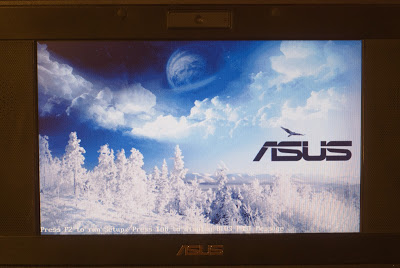
A little stitched bios.

Getting into the hands of this device was the starting point of the mod: an external USB hard drive 1.8 ".
Transcend StoreJet 18M market.yandex.ru/model.xml?modelid=4741348&hid=91033&suggest=1
Naturally the device was immediately dissected.
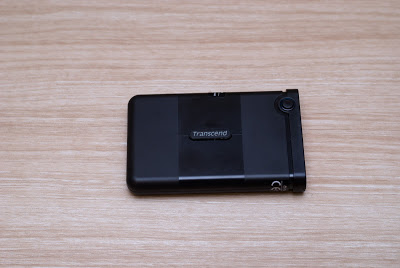
A plastic case was found under the protective rubber.

And below it is another rubber container directly for the hard drive.

Despite the rather impressive dimensions of the box, the hard drive itself was very small (70x50x5).

Quickly disassemble the netbook.

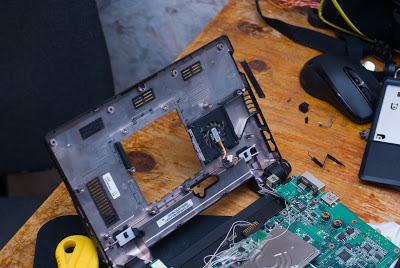
I estimate the hard drive in place and cut off the interfering plastic, there you can see a non-standard Bluetoeth module hanging on the wires.

The USB-IDE adapter was removed from the standard box and the standard miniUSB connector was removed from it (there is also an option to get the hard drive directly to the netbook's IDE interface, but it is complicated by the need to unplug 44+ wires in a very small space, I decided that I would have enough speed ).

Bluetoeth module had to be unsoldered, there are only two internal USB ports.
In its place soldered adapter USB-IDE.

We insert the ZIF loop and carefully isolate everything.
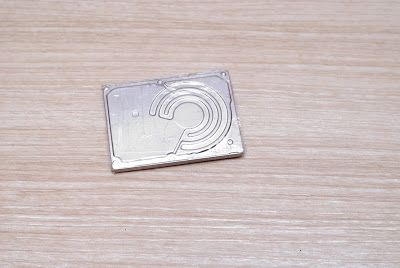
No less carefully isolate the hard drive case.

We install the motherboard in a regular place (you can see the wiring from another mod, it will be about it later).
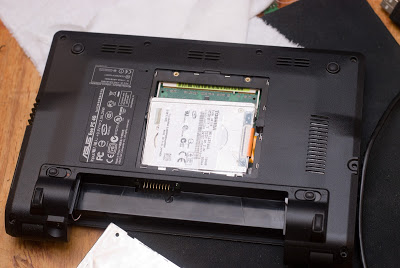

We connect the winchester and we lay out loops.


We return to the place of the old USB receiver from the radio mouse.

Test run the system uses a powerful cooling of the coins. The flight is normal, you can collect.
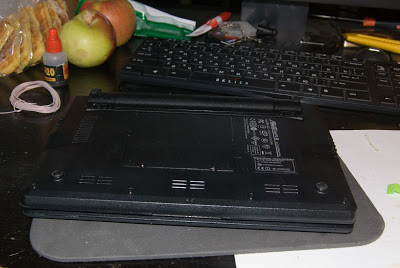
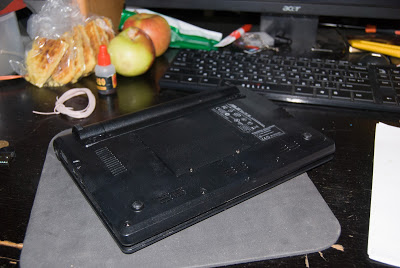
Finally collect. The only difference is the memory compartment cover, which extends a millimeter.
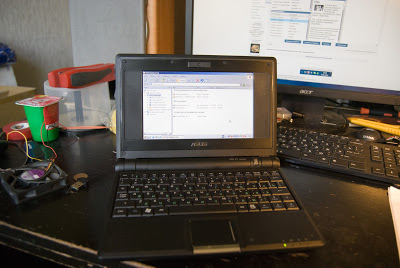

Done! The result is pleasing to the eye :)
And it was in that netbook, although the SSD was only 4 gigabytes, which is certainly enough for the system, but for everything else, you had to use an external screw and SDHC cards, you were tired of wearing an external screw, and there was little space on the cards, but the way out was found.

For the rest, welcome under cat. ( traffic )
The netbook is quite an ordinary ASUS EEE PC 701, bought as soon as it appeared in Russia and has since gone through a lot.
')


Outwardly, nothing special, classic black matte case and matte screen, very nicely assembled no backlash and gloss.

A little stitched bios.

Getting into the hands of this device was the starting point of the mod: an external USB hard drive 1.8 ".
Transcend StoreJet 18M market.yandex.ru/model.xml?modelid=4741348&hid=91033&suggest=1
Naturally the device was immediately dissected.

A plastic case was found under the protective rubber.

And below it is another rubber container directly for the hard drive.

Despite the rather impressive dimensions of the box, the hard drive itself was very small (70x50x5).

Quickly disassemble the netbook.


I estimate the hard drive in place and cut off the interfering plastic, there you can see a non-standard Bluetoeth module hanging on the wires.

The USB-IDE adapter was removed from the standard box and the standard miniUSB connector was removed from it (there is also an option to get the hard drive directly to the netbook's IDE interface, but it is complicated by the need to unplug 44+ wires in a very small space, I decided that I would have enough speed ).

Bluetoeth module had to be unsoldered, there are only two internal USB ports.
In its place soldered adapter USB-IDE.

We insert the ZIF loop and carefully isolate everything.

No less carefully isolate the hard drive case.

We install the motherboard in a regular place (you can see the wiring from another mod, it will be about it later).


We connect the winchester and we lay out loops.


We return to the place of the old USB receiver from the radio mouse.

Test run the system uses a powerful cooling of the coins. The flight is normal, you can collect.


Finally collect. The only difference is the memory compartment cover, which extends a millimeter.


Done! The result is pleasing to the eye :)
Source: https://habr.com/ru/post/94934/
All Articles